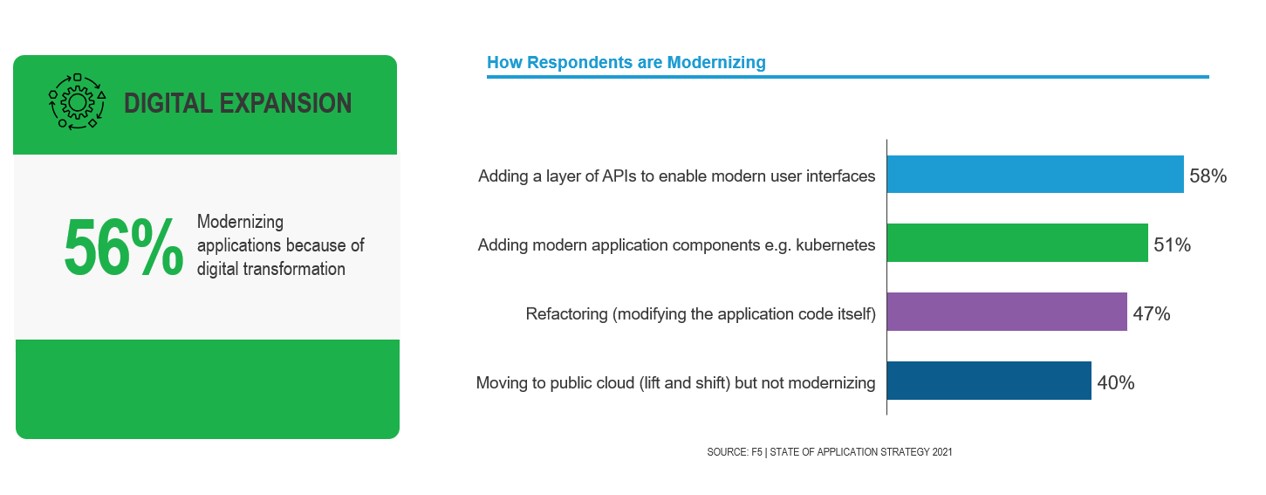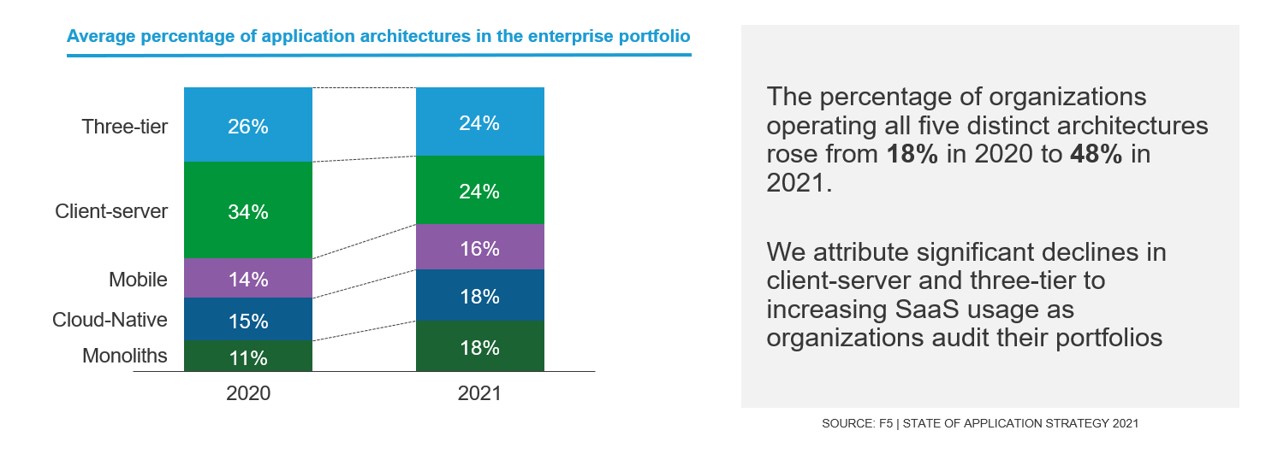Stand der Bewerbungsstrategie 2021: Modernisierungswahn
Wenn wir (das heißt das Wir im Unternehmen) über die digitale Transformation sprechen, verwenden wir einen Rahmen, der aus drei Phasen besteht . Dieses Framework bildet die technologische Entwicklung ab, die den geschäftlichen Übergang von physischen zu digitalen Modellen begleitet. Jede Phase ist durch eine Geschäftsinitiative gekennzeichnet, die durch Technologie ermöglicht wird.
Die zweite Phase, die digitale Expansion, ist durch Modernisierung gekennzeichnet. In dieser Phase bauen Unternehmen ihre digitale Präsenz aus. Am deutlichsten zeigen sich diese Bemühungen in den online angebotenen digitalen Erlebnissen, sie sind jedoch nicht auf Websites und mobile Apps beschränkt. Diese Phase umfasst die Digitalisierung von Produkten und ist teilweise die Ursache für den rasanten Anstieg der „vernetzten“ Geräte und der Apps, mit denen sie betrieben werden, wodurch eine Edge 2.0-Plattform dringend erforderlich wird.

Deshalb hat der Begriff Modernisierung Auswirkungen, die über eine neue Website hinausgehen. Durch Modernisierung schaffen Unternehmen nahtlose Erfahrungen, die sich über Produkte und Prozesse erstrecken. Unseren Untersuchungen zufolge ist dies bei vielen Unternehmen der Fall.
Modernisierungswahn
Über die Hälfte (56 %) der Befragten gaben an, dass sie aufgrund von Initiativen zur digitalen Transformation Anwendungen modernisieren. Eine Modernisierung ist notwendig, da viele der Monolithen, auf die sich das Unternehmen für seine Kerngeschäftsfunktionen verlässt, nicht die Art von Schnittstelle bieten können, die die Verbraucher erwarten.
Modernisierung ist keine neue Idee. Organisationen modernisieren Monolithen bereits seit der Zeit vor meiner Collegezeit. Der bedeutende Beitrag von Client-Server- und dreischichtigen Web-Apps zum Enterprise-App-Portfolio ist ein Beweis für die Modernisierung. Viele dieser Apps wurden ausschließlich zu dem Zweck entwickelt, Zugriff auf bestehende, monolithische Kerngeschäftsanwendungen zu ermöglichen. Heutzutage ist das Wachstum mobiler und containernativer Anwendungen teilweise auf die Modernisierung zurückzuführen.
Tatsächlich belegen die Daten dies. Organisationen modernisieren Anwendungen in erster Linie, indem sie sie um modernere Gegenstücke erweitern – containernative Apps und APIs.

Wenn wir uns einige Daten zur Bereitstellung von Anwendungen in Containern genauer ansehen, erkennen wir die Auswirkungen der Modernisierung. Bei Unternehmen, die sich in den späteren Phasen der digitalen Transformation befinden, ist die Wahrscheinlichkeit doppelt so hoch, dass sie mehr als die Hälfte ihres Anwendungsportfolios in Containern betreiben.
Modernisierung mit Auswirkungen auf das Anwendungsportfolio
Wir sehen auch eine deutliche Verschiebung im Unternehmensportfolio. Kein dramatischer Anstieg bei mobilen und Container-nativen Anwendungen, aber ein deutlicher Rückgang des Prozentsatzes veralteter, traditioneller Anwendungen. Sowohl Client-Server- als auch dreischichtige Webanwendungen machen in diesem Jahr einen viel kleineren Teil des Unternehmensportfolios aus.
Eine selten erwähnte, aber wesentliche Modernisierungsmaßnahme ist ein Portfolio-Audit. Diese Audits decken doppelte Funktionen auf, die eliminiert werden können, sowie Geschäftsanwendungen, die nun problemlos durch ein vergleichbares SaaS-Angebot ersetzt werden können. Sicherlich ist ein Teil des Wachstums bei modernen Anwendungen auf die Modernisierung zurückzuführen, doch größere Auswirkungen auf das Portfolio hat es, wenn Unternehmen ihr Portfolio bereinigen und rationalisieren.

Methoden sind größtenteils additiv
Obwohl Refactoring auch heute noch einer der beliebtesten Begriffe im Technologiemarketing ist, zeigen die Daten, dass es sich dabei nicht um die gängigste Methode zur Modernisierung von Anwendungen handelt – es sei denn, Sie sind ein Technologieunternehmen.
Als wir uns ansahen, wie Unternehmen modernisierten, stellten wir fest, dass fast die Hälfte (44 %) ausschließlich APIs (61 %) oder moderne Komponenten (54 %) nutzte, um die digitale Präsenz ihres Portfolios zu erweitern. Bei Unternehmen in den Bereichen Finanzdienstleistungen, Versorgung, Fertigung und Telekommunikation war die Wahrscheinlichkeit, dass sie APIs oder moderne Komponenten anstelle von Refactoring verwendeten, mehr als doppelt so hoch.
Dies dürfte nicht überraschen. Obwohl viele Technologien nach technologischen Maßstäben als ziemlich alt gelten, betreiben Unternehmen in etablierten und ausgereiften Branchen bereits seit längerer Zeit Anwendungen, als ich am Leben bin. Das ist eine lange Zeit, das gebe ich ohne Scham zu. Daher sind die Kosten und der Aufwand für die Umgestaltung der Kernanwendungen erheblich höher als bei einem relativ jungen Technologieunternehmen.
Dennoch ist es gut zu wissen, dass bei der Modernisierung von Unternehmen alle vier Modernisierungsmethoden – einschließlich Lift and Shift in die öffentliche Cloud – zur Verfügung stehen. Reduzieren, wiederverwenden und recyceln eignen sich gut für eine Strategie zur Anwendungsmodernisierung:
- Reduzieren Sie die Anzahl der Anwendungen im Unternehmensportfolio durch ein gründliches Audit. Beseitigen Sie Redundanzen und übernehmen Sie, wenn möglich, SaaS-Äquivalente.
- Verwenden Sie bewährte, traditionelle Apps erneut, indem Sie sie mit APIs und modernen Komponenten erweitern, die nahtlose digitale Erlebnisse und Konnektivität zu Ökosystemen von Drittanbietern ermöglichen.
- Recyceln Sie die vorhandene Logik, indem Sie sie in neue Anwendungen umgestalten und Zugriffs- und Betriebsmodelle effektiv modernisieren, um die Geschwindigkeit zu verbessern, mit der neue Funktionen und Sicherheitsmaßnahmen bereitgestellt werden können.
Die Folgen der Modernisierung
Langjährige Leser werden an dieser Stelle erkennen, dass Änderungen in Anwendungsarchitekturen erhebliche Auswirkungen auf jede andere Technologie und insbesondere auf Anwendungsbereitstellungs- und Sicherheitstechnologien (die Technologien, die früher als Anwendungsdienste bekannt waren) haben.
Es sind jedoch nicht nur die Änderungen in den Anwendungsarchitekturen, die den Wandel im gesamten Technologiespektrum vorantreiben. Die Art und Weise, wie Anwendungen zusammengefügt werden, um nahtlose digitale Erlebnisse zu liefern, stört bestehende Überwachungsmethoden und führt zu einer neuen Art der Analyse. Automatisierung und Orchestrierung sind entscheidende Funktionen, die für die Verwaltung des zunehmend Multi-Cloud-Portfolios erforderlich sind. Unternehmen haben jedoch Schwierigkeiten, die Tools zu finden, die sie hierfür benötigen.
Natürlich gibt es noch mehr, und wir werden noch tiefer graben, während wir den Stand der Anwendungsstrategie 2021 weiter untersuchen. In der Zwischenzeit können Sie sich im diesjährigen Bericht weitere Informationen zum Thema Modernisierung holen .
